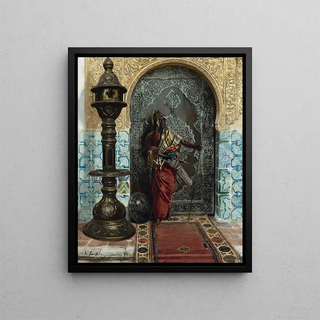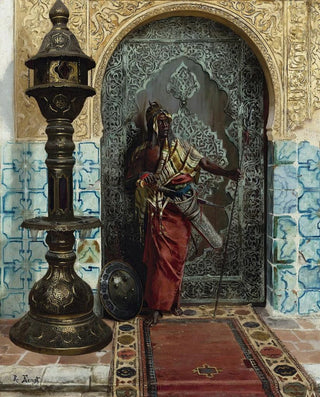Nubian Guard - Rudolf Ernst Art print


View from behind

Frame (optional)
In the fascinating world of orientalist art, Rudolf Ernst's "Garde nubienne" stands out for its depth and authenticity. This canvas, imbued with a mystical atmosphere, transports us to the sunlit landscapes of Africa, where the meeting of cultures and traditions unfolds in all its splendor. Through this art print, viewers are invited to explore not only the beauty of the depicted subjects but also the history and stories hidden behind each brushstroke. The artist, a true storyteller, manages to capture the very essence of his models, immersing us in a world rich in colors and emotions.
Style and uniqueness of the work
Rudolf Ernst's style is characterized by meticulous attention to detail and a vibrant color palette that breathes life into his compositions. In "Garde nubienne," warm hues evoke the heat of the African climate, while delicately worked shadows add an almost tactile dimension to the piece. The artist succeeds in creating an atmosphere of serenity and contemplation, where the gaze is lost in the patterns of the characters' traditional clothing. Every element of the canvas, whether ornaments or facial expressions, reflects a deep respect for Nubian culture. This attention to detail, combined with undeniable technical mastery, gives the work a singularity that makes it timeless and universal.
The artist and his influence
Rudolf Ernst, born in Vienna in 1854, was a painter whose work is part of the 19th-century orientalist movement. His passion for exotic cultures led him to travel across the Orient and Africa, experiences that profoundly influenced his art. Ernst does not merely reproduce picturesque scenes; he seeks to understand and convey the soul of the peoples he depicts. His works reflect a fascination with the other, but also a desire for sharing and intercultural dialogue. Through "Garde nubienne," he manages to build a bridge between the West and Africa, revealing the beauty and richness of a often little-known culture. His artistic legacy continues to inspire many contemporary artists.

Matte finish

View from behind

Frame (optional)
In the fascinating world of orientalist art, Rudolf Ernst's "Garde nubienne" stands out for its depth and authenticity. This canvas, imbued with a mystical atmosphere, transports us to the sunlit landscapes of Africa, where the meeting of cultures and traditions unfolds in all its splendor. Through this art print, viewers are invited to explore not only the beauty of the depicted subjects but also the history and stories hidden behind each brushstroke. The artist, a true storyteller, manages to capture the very essence of his models, immersing us in a world rich in colors and emotions.
Style and uniqueness of the work
Rudolf Ernst's style is characterized by meticulous attention to detail and a vibrant color palette that breathes life into his compositions. In "Garde nubienne," warm hues evoke the heat of the African climate, while delicately worked shadows add an almost tactile dimension to the piece. The artist succeeds in creating an atmosphere of serenity and contemplation, where the gaze is lost in the patterns of the characters' traditional clothing. Every element of the canvas, whether ornaments or facial expressions, reflects a deep respect for Nubian culture. This attention to detail, combined with undeniable technical mastery, gives the work a singularity that makes it timeless and universal.
The artist and his influence
Rudolf Ernst, born in Vienna in 1854, was a painter whose work is part of the 19th-century orientalist movement. His passion for exotic cultures led him to travel across the Orient and Africa, experiences that profoundly influenced his art. Ernst does not merely reproduce picturesque scenes; he seeks to understand and convey the soul of the peoples he depicts. His works reflect a fascination with the other, but also a desire for sharing and intercultural dialogue. Through "Garde nubienne," he manages to build a bridge between the West and Africa, revealing the beauty and richness of a often little-known culture. His artistic legacy continues to inspire many contemporary artists.






